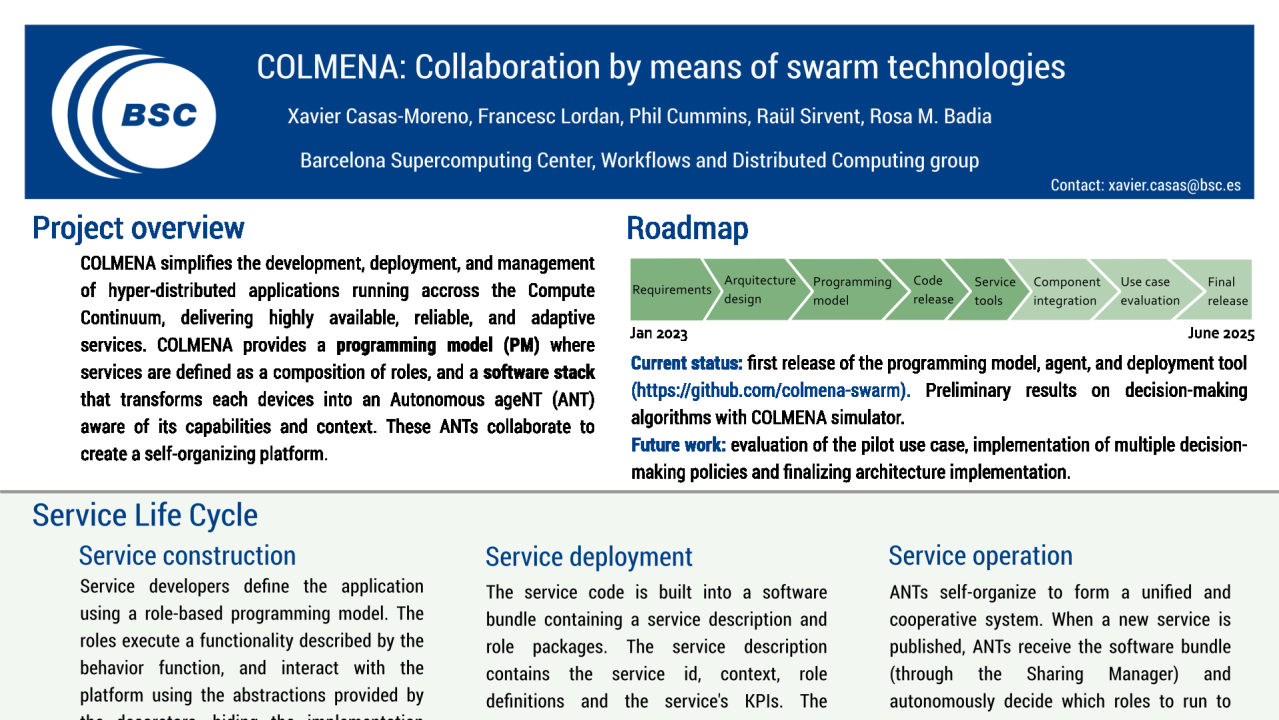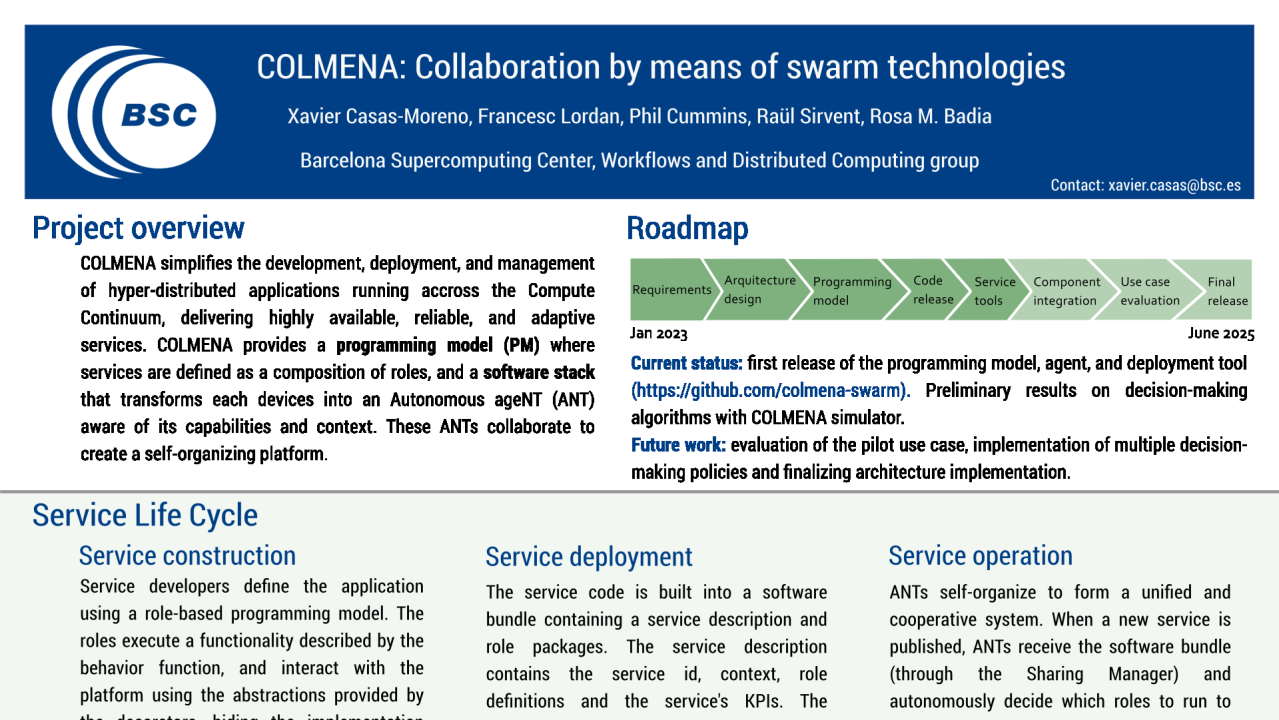

COLMENA: Collaboration by Means of Swarm Technologies
Tuesday, June 10, 2025 3:00 PM to Thursday, June 12, 2025 4:00 PM · 2 days 1 hr. (Europe/Berlin)
Foyer D-G - 2nd floor
Research Poster
Parallel Programming LanguagesResource Management and Scheduling
Information
Poster is on display and will be presented at the poster pitch session.
The Compute Continuum—spanning IoT, Edge, and Cloud—has emerged as a foundation for deploying hyper-distributed applications that demand low latency, high availability, and secure services across a dynamic, heterogeneous network of devices. This paradigm enables services to be executed closer to the data source, reducing response times and network overhead. However, this increased distribution and decentralization introduce significant challenges, particularly in efficiently allocating functionalities across diverse devices to maximize resource usage while adapting to a changing environment.
The heterogeneity of devices, ranging from low-power sensors to powerful compute nodes, and the vast number of managed components require adaptive orchestration. Traditional solutions rely on centralized controllers or static configurations, which often become bottlenecks or fail to respond effectively to dynamic events such as device failures, network congestion, or fluctuating workloads. These approaches consume significant resources and lack the scalability for highly distributed, large-scale deployments. The key challenge is to design an autonomous, decentralized system that can dynamically decide which devices should take on specific roles or functionalities without requiring manual intervention or centralized coordination.
To address these challenges, we present COLMENA, a programming environment that enables the definition and deployment of hyper-distributed applications in the Compute Continuum. COLMENA introduces a novel approach in which services are described as compositions of roles using a programming model. Each role encapsulates a behavior that represents a specific functionality, a set of hardware requirements, and abstractions. Each device hosts the COLMENA Agent middleware to become an Autonomous ageNT (ANT), aware of its own context and cyber-physical capabilities. ANTs decide which roles to run based on their properties and Quality of Service (QoS), forming a decentralized decision-making platform.
COLMENA supports the service lifecycle, from construction to deployment and operation. During service construction, developers define a service by specifying roles, associated behaviors, resource requirements, and abstractions using the programming model. In the service deployment phase, the software bundle containing the service is distributed to all ANTs in the platform using peer-to-peer technologies. During the service operation phase, ANTs present themselves as a unified platform. They monitor the QoS using performance indicators and autonomously decide which roles to run based on decision-making policies and role requirements. The decision-making process for role selection within COLMENA can be tailored through different policies.
The COLMENA project is ongoing (Jan 2023 - June 2025) and is conducted in collaboration with subcontracted companies (Eviden and eRoots Analytics). Currently, we have released the first version of the programming model, agent, and deployment tool on GitHub. We have also developed a custom-built simulator that emulates ANTs in a centralized manner to evaluate different decision-making policies. We have implemented reinforcement learning algorithms for role selection and compared them with random decision-making. Future work involves the implementation of a pilot use case involving dynamic configuration and adaptation of the electrical grid with renewable energies, investigation of other decision-making policies based on multi-agent reinforcement learning, game theory, and consensus, and the final release of the architecture.
The Compute Continuum—spanning IoT, Edge, and Cloud—has emerged as a foundation for deploying hyper-distributed applications that demand low latency, high availability, and secure services across a dynamic, heterogeneous network of devices. This paradigm enables services to be executed closer to the data source, reducing response times and network overhead. However, this increased distribution and decentralization introduce significant challenges, particularly in efficiently allocating functionalities across diverse devices to maximize resource usage while adapting to a changing environment.
The heterogeneity of devices, ranging from low-power sensors to powerful compute nodes, and the vast number of managed components require adaptive orchestration. Traditional solutions rely on centralized controllers or static configurations, which often become bottlenecks or fail to respond effectively to dynamic events such as device failures, network congestion, or fluctuating workloads. These approaches consume significant resources and lack the scalability for highly distributed, large-scale deployments. The key challenge is to design an autonomous, decentralized system that can dynamically decide which devices should take on specific roles or functionalities without requiring manual intervention or centralized coordination.
To address these challenges, we present COLMENA, a programming environment that enables the definition and deployment of hyper-distributed applications in the Compute Continuum. COLMENA introduces a novel approach in which services are described as compositions of roles using a programming model. Each role encapsulates a behavior that represents a specific functionality, a set of hardware requirements, and abstractions. Each device hosts the COLMENA Agent middleware to become an Autonomous ageNT (ANT), aware of its own context and cyber-physical capabilities. ANTs decide which roles to run based on their properties and Quality of Service (QoS), forming a decentralized decision-making platform.
COLMENA supports the service lifecycle, from construction to deployment and operation. During service construction, developers define a service by specifying roles, associated behaviors, resource requirements, and abstractions using the programming model. In the service deployment phase, the software bundle containing the service is distributed to all ANTs in the platform using peer-to-peer technologies. During the service operation phase, ANTs present themselves as a unified platform. They monitor the QoS using performance indicators and autonomously decide which roles to run based on decision-making policies and role requirements. The decision-making process for role selection within COLMENA can be tailored through different policies.
The COLMENA project is ongoing (Jan 2023 - June 2025) and is conducted in collaboration with subcontracted companies (Eviden and eRoots Analytics). Currently, we have released the first version of the programming model, agent, and deployment tool on GitHub. We have also developed a custom-built simulator that emulates ANTs in a centralized manner to evaluate different decision-making policies. We have implemented reinforcement learning algorithms for role selection and compared them with random decision-making. Future work involves the implementation of a pilot use case involving dynamic configuration and adaptation of the electrical grid with renewable energies, investigation of other decision-making policies based on multi-agent reinforcement learning, game theory, and consensus, and the final release of the architecture.
Format
On DemandOn Site
